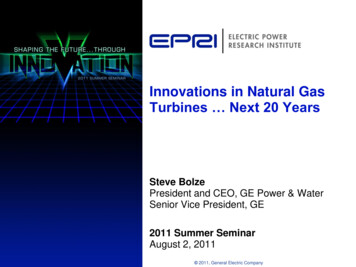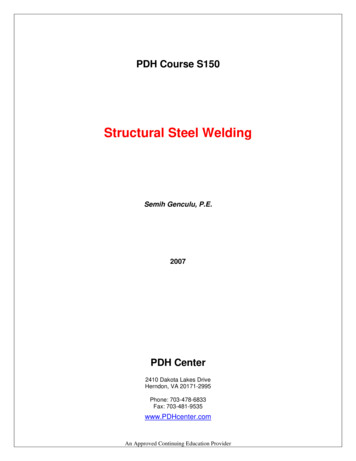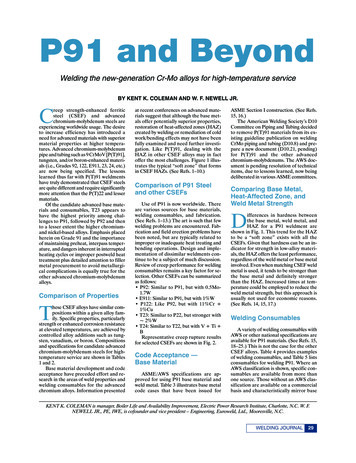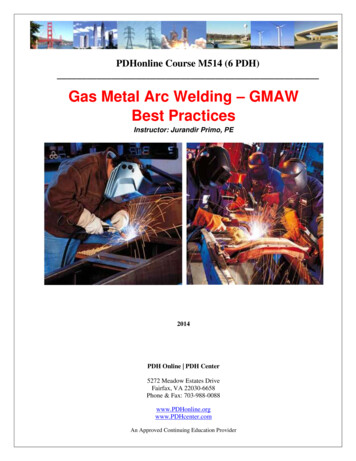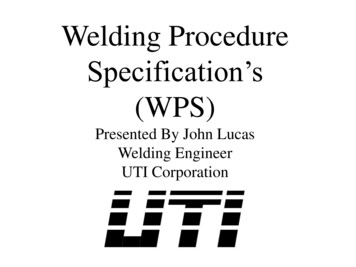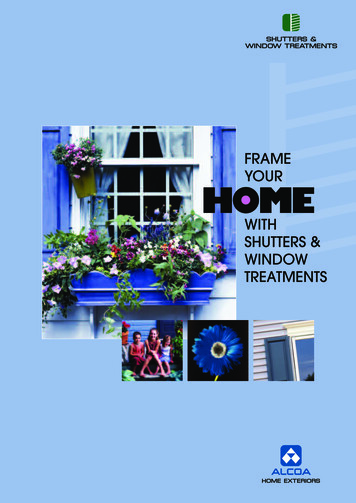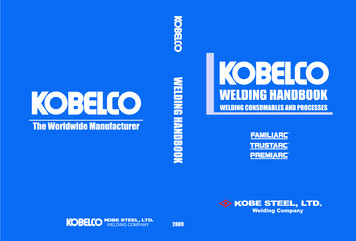
Transcription
WELDING HANDBOOKWELDING COMPANY2009
Overall IndexLists of Welding Consumables10For Mild Steel and 490MPa High Tensile Strength SteelFor Weather Proof Steel83For 590-780MPa High Tensile Strength Steeland Low Temperature SteelFor Heat-Resistant Low-Alloy Steel97155For Stainless SteelFor Hardfacing207265For Cast IronFor Nickel-Based Alloy287293Highly Efficient Welding ProcessesAppendix23313327 For your further information of welding consumable specifications, classifications, approvals andpackages, please contact the nearest Kobelco office or sales representative.
NotificationThe purpose of changing the designation systemWe, Welding Company of Kobe Steel, Ltd., thank you very much for your continuous patronage of ourproducts and services. We have changed the designation system of welding consumable as described inthe following from April 2008. However, the technical design of the products is not changed.New group brand names and the corresponding productsAll KOBELCO welding consumables are designated with “Trade Designation” and are grouped into thefollowing three new groups on the basis of the characteristics of individual products as detailed below.(1)(Famili-Arc)A coined word produced by combining “Familiar” and “Arc.”Welding consumables grouped into this group are used for general welded structures made of mildsteels and high tensile strength steels that have the tensile strength of less than 590 MPa.(2)In recent years, we have found some other companies’ products that have the same brand names asours and false certificates that misrepresent our company’s certificates in Japan and the Asian countries.In order to cope with this problem, we have taken legal actions against the impostors that could beverified and have required them to change their product names. However, it is difficult in the traditionalproduct designation system to protect all of our products from imitation. Hence, we have established thenew designation system of welding consumable to ensure the trademark right in main countries and tomake our products identifiable more clearly, in which the particular group brand name, “Trademark,” isput on the head of an individual “Trade Designation.”The new designation system is not only to prevent counterfeit products in Japan and overseas countries,but also to prevent our customers and users from suffering such a trouble in terms our products.This modification may cause customers and users to modify their relevant documents. We sincerelyhope for your understanding of the abovementioned situation and for your cooperation with us.(Trust-Arc)A coined word produced by combining “Trust” and “Arc.”Welding consumables grouped into this group are used for such steels that require highly crediblequalities as high tensile strength steels with the tensile strength of 570 MPa and higher, lowtemperature steels, and heat-resistant low-alloy steels.(3)(Premi-Arc)A coined word produced by combining “Premium” and “Arc.”Welding consumables grouped into this group are used for high-alloy steels, stainless steels, andnonferrous metals.The new group brand name (referred to as “Trademark” hereinafter) is put on the head of an individualtrade designation. The trade designations are made by modifying the traditional brand names inaccordance with the new designation system in which the position of hyphen is reviewed so that ahyphen comes after one letter or two letters. That is, the new brand name consists of “Trademark” and“Trade designation” as shown in the following. We are determined to control all the trade designations sothat they can clearly be identified.Examples of new and old brand namesOld brand name2New brand name(1) B-10B-10(2) MG-50MG-50(3) TGS-50TG-S50(4) MGS-50MG-S50(5) ZERODE-44Z-44(6) CMA-106NCM-A106N(7) DW-308DW-308Note: The trademarks may be used with the following symbols in this booklet.[F]: FAMILIARC ; [T]: TRUSTARC ; [P]: PREMIARC .3
ForewordAbbreviations and marks with definitionsNote the following preliminary information on use of this welding handbook.This welding handbook uses the following abbreviations and marks if necessary.1. Standards for welding consumables are abbreviated as followsJIS: Japanese Industrial StandardAWS: American Welding Society’s StandardEN: European NormASME: American Society of Mechanical Engineers’ Standard2. Classifications for welding consumables are used in accordance with the following rulesWelding consumables are classified in accordance with basically the mechanical and/or chemicalrequirements of the standards, excluding such requirements as size, length, marking andidentification manners. For details please contact the nearest Kobelco office or salesrepresentative.3. The test conditions of mechanical properties and hardness are as follows(1) Unless otherwise specified, impact values are obtained with Charpy 2mm-V notch specimens.(2) Unless otherwise specified, tension test and hardness test are carried out at room temperature.(3) Unless otherwise specified, tension test and hardness test are carried out in the as-weldedcondition.(4) The gauge length of tensile specimens is 4 x D (where D is the diameter) for testing at roomtemperature.(5) Unless otherwise specified, postweld heat treatment is followed by furnace cooling.(6) Unless otherwise specified, the testing method is as per AWS standard.(7) All mechanical and chemical data are given separately as “Example” (one of the manufacturer’slaboratory test data) and “Guaranty” (the guaranty value as per AWS standard). Tensilestrength and 0.2% offset strength are rounded as SI unit.4. The weight per piece of covered electrode shows an approximate weight4Abbrev.and CAWGDGMAWGSGTAWHHAZHFHIHTHvI PTIVL(L)MSNEDefinitionAlternating current or Air coolingAmpereAll positionsAs-weldedBalanceCooling rateDistance between electrodesDirect currentDC, electrode negativeDC, electrode positiveDiameterElectrogas arc weldingElongationExtension of wireFlat positionFurnace coolingFlux-cored wireFlux Cored Arc WeldingGroove designGas Metal Arc WeldingGroove sizeGas Tungsten Arc WeldingHorizontal positionHeat-affected zoneHorizontal filletHeat inputHigh tensileHardness (Vickers)Interpass temperatureImpact valueLengthLeading electrodeMild steelNumber of electrodeAbbrev.and markNLNRODOQOSOSWPolPre. P DefinitionNumber of layerNot requiredOuter diameterOil quenchingOffset strengthOne-side weldingPolarityPreheatPlate thicknessPostweld heat treatmentReduction of areaRedrying conditionsRoot gapRoom temperatureSubmerged arc weldingShielding gasShielded metal arc weldingStress reliefSolid wireTrailing electrodeTungsten inert gasTensile strengthTest temperatureVoltageVertical-down positionVertical-up positionWelding positionWater quenchingYield pointMaximumMinimum5
Warning and Caution in WeldingPay your attention to the following warnings and cautions for your safety and health during welding andrelated operationsWARNINGBe sure to follow safety practices stated in the following inorder to protect welders, operators and accompanied workersfrom a serious accident resulting in injury or death.CAUTIONFumes and gases generated during welding are dangerous toyour health.Welding in confined spaces is dangerous because it can be acause to suffocation by oxygen deficient. Be sure to follow safety practices stated in the following when you use weldingconsumables. Be sure to follow safety practices stated in the instruction manual of welding equipmentwhen you use it.WARNINGElectric shock can kill. Do not touch live electrical parts (A covered electrode held with an electrode holder and awelding wire are electrically live). Wear dry, insulated gloves. Do not wear torn or wet gloves. Use an electric shockpreventing device (e.g., open-circuit-voltage-reducing device) when welders or operatorswork in confined or high-level spaces. Use also a lifeline when welders or operatorsconduct welding at a high-level space. Follow safety practices stated in the instruction manual of welding machines before use.Do not use a welding machine the case or cover of which is removed. Welding cablesmust have an adequate size for the capacity expected. Welding cables must be kept inan appropriate condition and a damaged cable must be repaired or replaced with newone. Keep your head out of the source of fumes or gases to prevent you from directlybreathing high density fumes or gases. Use local exhaust ventilation, or wear respirators in order to prevent you from breathingfumes and toxic gases which cause toxication, poor health and suffocation by oxygendeficient. Use general ventilation during welding in a workshop. Particularly during welding inconfined spaces, be sure to use adequate ventilation or respirators, and welding shouldbe done at the presence of a trained supervisor. Do not conduct welding at where degreasing, solvent cleaning, spraying, or paintingoperations are carried out nearby. Welding work accompanied by these operations maycause generation of harmful gases. Use adequate ventilation or respirators with special attention during welding plated andcoated steels. Use respirators, eye safety glasses and safety leather gloves when using welding fluxesin order to prevent you from flux dust.CAUTIONArc rays can injure eyes and burn skin. Wear hand shields with an adequate shade grade during welding operations andsupervising the welding work. Select the correct shade grade for filter lenses and filterplates suitable for exact welding work by referring the standard JIS T81 41. Wear suitable protectors for protecting you from an arc ray; e.g., safety leather glove forwelding, long sleeve shirt, foot cover, leather apron. Use, at need, shade curtains for welding by surrounding the welding areas in order toprevent accompanied workers from arc rays.67
CAUTIONCAUTIONFire and explosion can take place.The tip of a welding wire and filler wire can injure eyes, faces, etc. Never conduct welding at areas adjacent to highly inflammable materials. Removecombustibles so that spatters cannot ignite them. If combustibles cannot be removed,cover them with a noninflammable material. Do not weld vessels or pipes which contain combustibles or being sealed. Do not put a hot weldment close to combustibles right after welding finished. When welding ceilings, floors, walls, remove combustibles put at the other side of them. Any part of a welding wire, with exception of the potion appropriately extended from thetip of the torch, must be free from touching the electrical circuit of the base metal side. Fasten cable joints and seal them with an insulation tape. The cable of the base metalside should be connected as close as possible to the welding portion of the work. Prepare fire-extinguishing equipment at where welding is carried out, in order to copewith a possible accident.CAUTIONFlying spatter and slag can injure eyes and cause skin burns.High temperature heat of welding can cause skin burns. When take off the tip of a wire fastened in the spool, be sure to hold the tip of the wire. When check the wire feeding condition, do not direct the welding torch to your face.CAUTIONFalling down or dropping welding consumables can injure you. Wear safety shoes and pay your attention not to drop welding consumables on your bodywhen carrying and handling them. Keep yourself in a correct posture not to cause a crickin your back while handling them. Follow the handling instructions shown on the surface of the pail pack wire packageswhen handle them. Pile up welding consumables in a correct way so as not to cause falling or dropping whilethey are stored or carried. Wear safety glasses, safety leather gloves for welding, long sleeve shirts, foot covers,leather aprons, etc. Do not touch weldments while they are hot.89
Lists of Welding ConsumablesWeldingProcessTrade designationASME/AWSASMEJISPageF No.A No.For Mild Steel and 490MPa High Tensile Strength SteelSMAWFCAW10WeldingProcessFCAWTrade designationASME/AWSASMEJISF No.PageA No.MX-100A5.20 E70T-1CZ3313 YFW-C50DM6162KOBE-6010A5.1 E6010-5140MX-200A5.20 E70T-1CZ3313 YFW-C50DM6156B-33A5.1 E6013Z3211 D43132146MX-200EA5.20 E70T-9CZ3313 YFW-C502M6157RB-26A5.1 E6013Z3211 D43132133MX-200HA5.20 E70T-1CZ3313 YFW-C50DM6162TB-24A5.1 E6013Z3211 D430321-MX-Z210A5.20 E70T-1Z3313 YFW-C50DM61-TB-I24A5.1 E6013Z3211 D430321-MX-A200A5.20 E70T-1MZ3313 YFW-A50DM6162Z-44A5.1 E6013Z3211 D43032146DW-100A5.20 E71T-1CZ3313 YFW-C50DR6152B-10A5.1 E6019Z3211 D43012146DW-100EA5.20 E71T-9CZ3313 YFW-C502R6153B-14A5.1 E6019Z3211 D43012132DW-100V6160A5.1 E6019Z3211 D43012146DW-50Z3313 YFW-C50DR6155Bl-14A5.1 E6019Z3211 D430121-DW-A50A5.20 E71T-1CA5.20 E71T-1C/1M,-9C/9MA5.20 E71T-1MZ3313 YFW-C50DRB-17Z3313 YFW-A50DR6154LB-26A5.1 E7016Z3211 D43164148DW-A51BA5.20 E71T-5M-JZ3313 YFW-A502B6160LB-47A5.1 E7016Z3211 D4316412666LB-52A5.1 E7016Z3212 D50164134LB-52RCA5.1 E7016Z3211 E49164138LB-52UA5.1 E7016Z3211 D43164135LB-M52A5.1 E7016Z3212 D50164126LB-52AA5.1 E7016Z3212 D50164148LB-57A5.1 E7016Z3212 D53164-48LT-B52AA5.1 E7018Z3212 D50164150LB-52-18A5.1 E7018Z3212 D50164136KOBE-7024A5.1 E7024-1139LB-26VA5.1 E7048Z3211 D431641-LB-52TA5.1 E7048Z3212 D50164148LB-52VA5.1 E7048Z3212 D501641-LB-78VSA5.1 E7048-4143KOBE-7010SA5.5 E7010-P1-3-41LB-76A5.5 E7016-GZ3212 D53164148KOBE-8010SA5.5 E8010-P1-3-42GMAWMIX-50A5.18 ER70S-3Z3312 YGW1661MG-51TA5.18 ER70S-6Z3312 YGW126165MIX-50SA5.18 ER70S-GZ3312 YGW156166MG-50A5.18 ER70S-GZ3312 YGW116164MG-S50A5.18 ER70S-GZ3312 YGW166166--66MG-50DGTAWSAWA5.18 ER70S-GZ3312 YGW12-1NO65GA5.18 ER70S-2Z3316 YGT506170TG-S51TA5.18 ER70S-6Z3316 YGT506169TG-S50A5.18 ER70S-GZ3316 YGT506168PF-H45/US-43A5.17 F6A4-EL8Z3183 S422-S6178MF-44/US-36A5.17 F7A0-EH14Z3183 S501-H6--MF-53/US-36A5.17 F7A0-EH14Z3183 S501-H6-78G-50/US-36A5.17 F7A2-EH14Z3183 S502-H6-72G-60/US-36A5.17 F7A2-EH14A5.17 F7A2-EH14,F6P2-EH14A5.17 F7A4-EH14Z3183 S502-H6-73G-80/US-36LB-88VSA5.5 E8018-G-4-
This welding handbook uses the following abbreviations and marks if necessary. Abbrev. and mark Definition Abbrev. and mark Definition AC Alternating current or Air cooling NL Number of layer A Ampere NR Not required AP All positions OD Outer diameter AW As-welded OQ Oil quenching Bal Balance OS Offset strength CR Cooling rate OSW One-side welding DBE Distance between electrodes Pol
